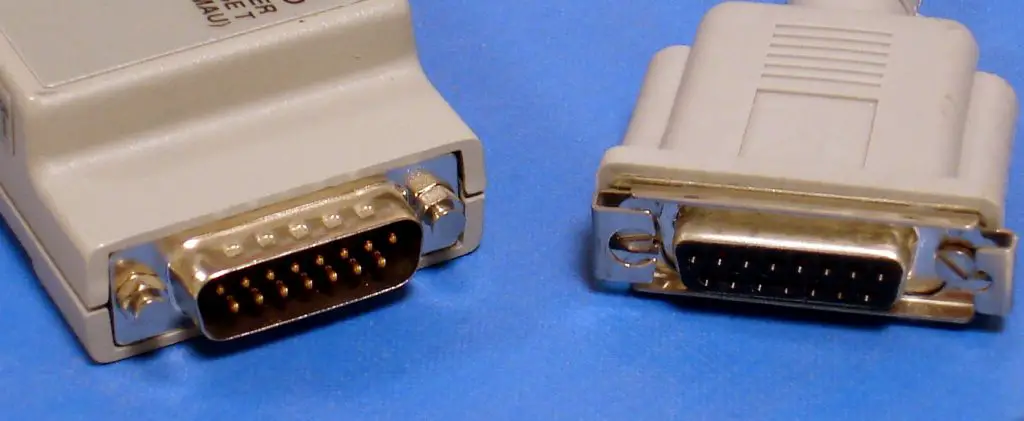In the early days of networking, during the era of “MAU,” “MAC,” and 10Base5 networks, the AUI connector, short for Attachment Unit Interface, was the standard. This article will explain how this connector functioned, the reasons behind its replacement, and the subsequent technology that emerged.
In this article:
- What was the AUI Connector?
- AUI Pinout
- Historical Context
- Technical Evolution
- Legacy and Modern Relevance
- References
1. What is the AUI Connector?
AUI is an acronym for Attachment Unit Interface connector, a standard 15-pin connector device for thicknet or 10Base5 cabling. The AUI connector on the free end of the drop cable attaches to the DB15 connector on the network interface card (NIC). The NIC has an AUI port connector for connecting the drop cable.

The other end of the drop cable typically connects to a transceiver. The transceiver is then joined to the thicknet cabling using a vampire tap that pierces the cable jacket and insulation to make a connection.
2. AUI Pinout
An AUI connector is a DA-15 (D-subminiature). It has a sliding clip in place of the thumbscrews normally found on a D-connector to hold two connectors together. This clip permits the MAU and MAC to be directly attached to one another even when their size and shape would preclude the use of thumbscrews.
| Pin | Signal | Description |
|---|---|---|
| 3 | DO-A | Data Out Circuit A |
| 10 | DO-B | Data Out Circuit B |
| 11 | DO-S | Data Out Circuit Shield (not used) |
| 5 | DI-A | Data In Circuit A |
| 12 | DI-B | Data In Circuit B |
| 4 | DI-S | Data In Circuit Shield |
| 7 | CO-A | Control Out Circuit A (not used) |
| 15 | CO-B | Control Out Circuit B (not used) |
| 8 | CO-S | Control Out Circuit Shield (not used) |
| 2 | CI-A | Control In Circuit A |
| 9 | CI-B | Control In Circuit B |
| 1 | CI-S | Control In Circuit Shield |
| 6 | VC | Voltage Common (0 V) |
| 13 | VP | Voltage Plus (+12 V) |
| 14 | VS | Voltage Shield (not used) |
| Shell | PG | Protective Ground |
3. Historical Context
The evolution of computer networks has been rapid since its inception. The AUI connector, emerging in the 1980s, met the growing need for robust connectivity standards. This innovative connector allowed for flexible and reliable connections between network devices like computers and hubs. It was pivotal in 10Base5 networks, also known as 10 Mbps baseband Ethernet, one of the first widely adopted network technologies in businesses and organizations. The AUI connector, attributed to renowned scientist and electronic engineer Anant Agarwal, marked a significant advancement in network connectivity in the 1980s, providing a flexible interface for network devices and contributing greatly to the development of 10Base5 and subsequent technologies.
4. Technical Evolution
After its inception in the 1980s, the Attachment Unit Interface (AUI) connector played a pivotal role in computer networks, facilitating flexible and reliable device connectivity. However, in the face of rapid technological advancements, it encountered challenges stemming from limitations in speed and flexibility. The primary constraint of the AUI connector was its 10 Mbps transmission rate, which proved inadequate to meet the burgeoning demands for higher bandwidth.
As networks evolved and transmission speeds became a critical factor, the AUI connector gradually yielded ground to more advanced technologies, such as the RJ-45 connector and Ethernet 100Base-TX. The RJ-45 connector, coupled with twisted-pair cables, delivered significantly higher transmission rates, reaching 100 Mbps and beyond. This empowered networks to keep pace with escalating data traffic and the need for faster speeds.
Furthermore, the pliability of twisted-pair cables and the ease of deploying RJ-45 connectors made them the preferred choice for numerous network implementations. Technological evolution also ushered in more sophisticated switches and hubs, enhancing the efficiency and scalability of Ethernet networks.
In summary, the AUI connector was supplanted due to the imperative need for greater bandwidth and flexibility in modern networks. The transition to technologies such as RJ-45 and Ethernet 100Base-TX enabled networks to satisfy the mounting demands for speed and adapt to the dynamic technological landscape, rendering them more efficient and versatile.
5. Legacy and Modern Relevance
The legacy of the AUI (Attachment Unit Interface) connector is deeply intertwined with the history of computer networking. While it has been largely replaced by newer technologies, its impact and relevance in shaping the network landscape are still evident today.
Historical Significance
In the 1980s, the AUI connector was at the forefront of network connectivity, enabling the flexible interconnection of devices. It played a pivotal role in the early days of Ethernet, providing a standardized interface for connecting computers to the network. This facilitated the growth of local area networks (LANs) and the sharing of resources among connected devices.
Limitations and Evolution
However, as technology advanced and the need for higher speeds and greater flexibility arose, the AUI connector faced limitations. Its 10 Mbps transmission rate became insufficient in a world hungry for bandwidth. Consequently, it gradually gave way to more advanced solutions, such as the RJ-45 connector and Ethernet 100Base-TX. The transition marked a critical juncture in the evolution of networking technology.
Modern Relevance
While the AUI connector has become a relic of the past in many network environments, its legacy endures. Understanding its history and the challenges it addressed provides valuable insights into the foundations of modern networking. Moreover, its influence on the development of Ethernet and early LANs laid the groundwork for the robust networks we rely on today.
6. References
- RFC 1044 – “Internet Protocol on Network System’s HYPERchannel: Protocol Specification”
- RFC 1045 – “VMTP: Versatile Message Transaction Protocol”
- “Ethernet: The Definitive Guide” by Charles E. Spurgeon
- “TCP/IP Illustrated, Volume 1: The Protocols” by W. Richard Stevens